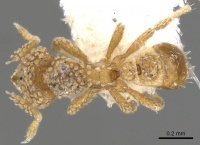Strumigenys lachesis
| Strumigenys lachesis | |
|---|---|

| |
| Scientific classification | |
| Kingdom: | Animalia |
| Phylum: | Arthropoda |
| Class: | Insecta |
| Order: | Hymenoptera |
| Family: | Formicidae |
| Subfamily: | Myrmicinae |
| Tribe: | Attini |
| Genus: | Strumigenys |
| Species: | S. lachesis |
| Binomial name | |
| Strumigenys lachesis (Bolton, 2000) | |
Nothing is known about the biology of Strumigenys lachesis.
Identification
Bolton (2000) - A member of the argiola complex in the Strumigenys argiola group. This minute species is close to Strumigenys hirashimai but with the marked pilosity differences noted in the diagnoses. Apart from pilosity the apicodorsal mandibular tooth of lachesis is smaller and shorter than in hirashimai, and funicular segments 2 and 3 are much smaller and less conspicuous.
Keys including this Species
Distribution
Distribution based on Regional Taxon Lists
Palaearctic Region: China (type locality).
Distribution based on AntMaps
Distribution based on AntWeb specimens
Check data from AntWeb
Countries Occupied
| Number of countries occupied by this species based on AntWiki Regional Taxon Lists. In general, fewer countries occupied indicates a narrower range, while more countries indicates a more widespread species. |

|
Estimated Abundance
| Relative abundance based on number of AntMaps records per species (this species within the purple bar). Fewer records (to the left) indicates a less abundant/encountered species while more records (to the right) indicates more abundant/encountered species. |

|
Biology
|
Castes
Nomenclature
The following information is derived from Barry Bolton's Online Catalogue of the Ants of the World.
- lachesis. Pyramica lachesis Bolton, 2000: 389 (w.) CHINA. Combination in Strumigenys: Baroni Urbani & De Andrade, 2007: 122
Unless otherwise noted the text for the remainder of this section is reported from the publication that includes the original description.
Description
Worker
Holotype. TL 1.5, HL 0.39, HW 0.36, CI 92, ML 0.12, MI 31, SL 0.17, SI 47, PW 0.24, AL 0.42. Apicodorsal tooth of mandible short and dentiform, not spiniform and no longer than apicoventral tooth. Mandible without preapical teeth. Dorsal surface and outer dorsolateral margin of mandible each with a longitudinal row of apically directed scale-like to spoon-shaped hairs that are decumbent to loosely appressed. Anterior clypeal margin with 6 elongate strap-like hairs that project anteriorly; the two pairs closest to the clypeal midline are shallowly curved away from the midline. Most hairs on leading edge of scape curved toward the base of the scape. Funicular segments 2 and 3 ( = antennal segments 3 and 4) very small, short and inconspicuous. Orbicular hairs present on dorsal surfaces of scape and all over the cephalic dorsum; those occurring medially on the clypeus are much smaller than those near its lateral or posterior margins. CI < 100. Mesonotum in profile not bulging posteriorly over base of propodeum. Dorsolateral margin of propodeum with 2-3 broadly spoon-shaped hairs that are strongly curved posteriorly; none on propodeal dorsum.
Type Material
Holotype worker, China: central Guangdong, Gutian, 3.iv.1997 (J. R. Fellowes) (The Natural History Museum).
References
- Baroni Urbani, C. & De Andrade, M.L. 2007. The ant tribe Dacetini: limits and constituent genera, with descriptions of new species. Annali del Museo Civico di Storia Naturale “G. Doria” 99:1-191.
- Bolton, B. 2000. The ant tribe Dacetini. Memoirs of the American Entomological Institute. 65:1-1028. (page 389, worker described)
- Tang, K. L., Guénard, B. 2023. Further additions to the knowledge of Strumigenys (Formicidae: Myrmicinae) within South East Asia, with the descriptions of 20 new species. European Journal of Taxonomy 907, 1–144 (doi:10.5852/ejt.2023.907.2327).
References based on Global Ant Biodiversity Informatics
- Xu Z. H., and X. G. Zhou. 2004. Systematic study on the ant genus Pyramica Roger (Hymenoptera, Formicidae) of China. Acta Zootaxonomica Sinica 29: 440-450.
- Xu Z. and X.-G. Zhou. 2004. Systematic study on the ant genus Pyramica Roger (Hymenoptera, Formicidae) of China. Acta Zootaxonomica Sinica 29(3): 440-450

